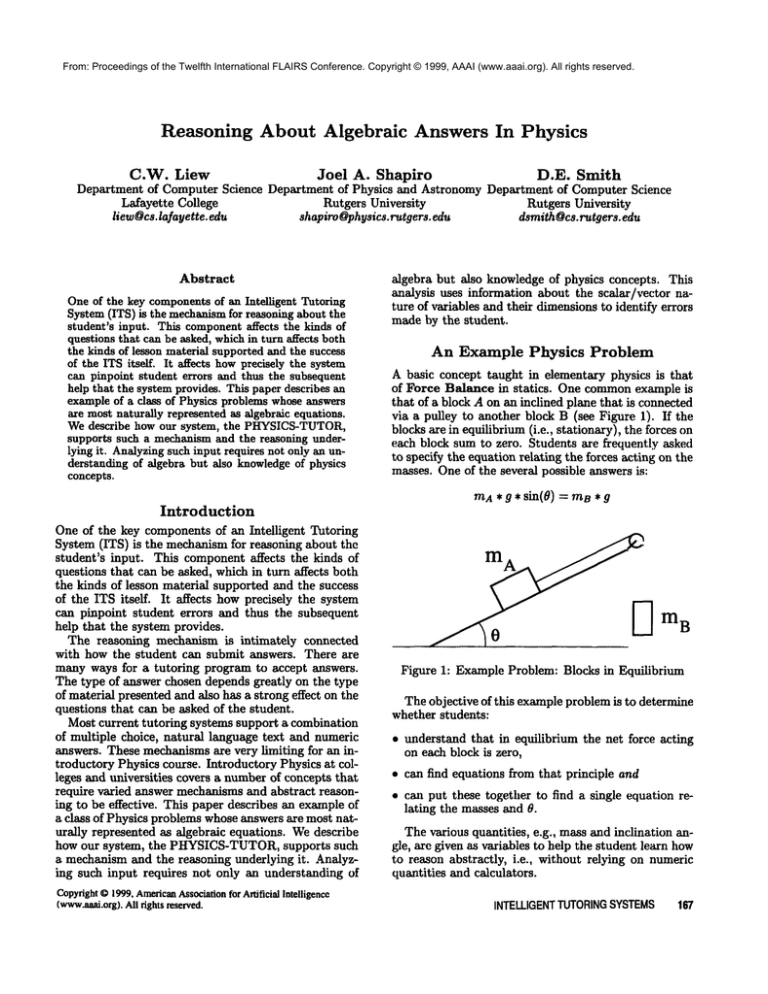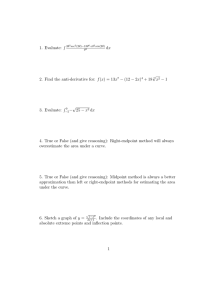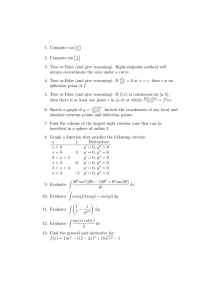
From: Proceedings of the Twelfth International FLAIRS Conference. Copyright © 1999, AAAI (www.aaai.org). All rights reserved.
Reasoning
About Algebraic
Answers In Physics
C.W. Liew
Joel
A. Shapiro
D.E. Smith
Department of Computer Science Department of Physics and Astronomy Department of Computer Science
Lafayette College
Rutgers University
Rutgers University
liew@cs,lafayette, edu
shapiro @physics.rutgers, edu
dsmith @cs.rutgers. edu
Abstract
Oneof the key componentsof an Intelligent Tutoring
System(ITS) is the mechanismfor reasoning about the
student’s input. This componentaffects the kinds of
questions that can be asked, whichin turn affects both
the kinds of lesson material supported and the success
of the ITS itself. It affects howprecisely the system
can pinpoint student errors and thus the subsequent
help that the systemprovides. This paper describes an
exampleof a class of Physics problems whoseanswers
are most naturally represented as algebraic equations.
We describe how our system, the PHYSICS-TUTOR,
supports such a mechanismand the reasoning underlying it. Analyzingsuch input requires not only an understanding of algebra but also knowledgeof physics
concepts.
algebrabutalsoknowledge
of physicsconcepts.
This
analysis
usesinformation
aboutthescalar/vector
natureof variables
andtheirdimensions
toidentify
errors
madeby thestudent.
An Example
Physics
Problem
A basic concept taught in elementary physics is that
of Force Balance in statics.
One commonexample is
that of a block A on an inclined plane that is connected
via a pulley to another block B (see Figure 1). If the
blocks are in equilibrium (i.e., stationary), the forces
each block sum to zero. Students are frequently asked
to specify the equation relating the forces acting on the
masses. One of the several possible answers is:
mA* g * sin(0) = ms *
Introduction
One of the key components of an Intelligent Tutoring
System (ITS) is the mechanism for reasoning about the
student’s input. This component affects the kinds of
questions that can be asked, which in turn affects both
the kinds of lesson material supported and the success
of the ITS itself. It affects how precisely the system
can pinpoint student errors and thus the subsequent
help that the system provides.
The reasoning mechanism is intimately connected
with how the student can submit answers. There are
many ways for a tutoring program to accept answers.
The type of answer chosen depends greatly on the type
of material presented and also has a strong effect on the
questions that can be asked of the student.
Most current tutoring systems support a combination
of multiple choice, natural language text and numeric
answers. These mechanismsare very limiting for an introductory Physics course. Introductory Physics at colleges and universities covers a number of concepts that
require varied answer mechanisms and abstract reasoning to be effective. This paper describes an example of
a class of Physics problems whose answers are most naturally represented as algebraic equations. Wedescribe
how our system, the PHYSICS-TUTOR,
supports such
a mechanism and the reasoning underlying it. Analyzing such input requires not only an understanding of
Copyright
©1999,American
Association
for ArtificialIntelligencc
(www.anai.org).
Allrightsresewed.
m
A
m
B
Figure1: ExampleProblem:
Blocksin Equilibrium
Theobjective
of thisexample
problem
isto determine
whether
students:
¯ understand that in equilibrium the net force acting
on each block is zero,
¯ can find equations from that principle and
¯ can put these together to find a single equation relating the masses and 0.
The,~rious
quantities,
e.g.,massandinclination
angle,aregivenas variables
tohelpthestudent
learnhow
to reasonabstractly,
i.e.,without
relying
on numeric
quantities
andcalculators.
INTELLIGENT
TUTORING
SYSTEMS 167
Existing
Reasoning
Mechanisms
In this section, we describe some commonlyused ways
of inputting answers and reasoning about them. We
also discuss the limitations of these approaches that the
PHYSICS-TUTORsystem addresses.
¯ multiple choice
This mechanism is easily implemented using WWW
technology (Novak & Patterson 1998; Hubler & Assad 1995; Nova&1997). Answers are easily graded
and the feedback to the student can be immediate,
an important consideration.
The main weakness of this approach is that it does
not encourage the development of abstract reasoning and also makes it difficult to determine how the
student generated the answer.
¯ natural language text
This relies heavily on the ability to use keywordsto
decipher an answer.
This is reasonable in some domains (Freedman 1997)
but not in Physics. There are too manyways to state
all equation to easily use natural language text analysis.
1. mA* g * sin(0) =mB* g
¯ numeric answers
This meckianism carl be coupled with simulation programs (e.g., written in JAVA)to show the implications of the student’s answers (Titus, Martin, & Beichner 1998). A problem could be phrased so that
there was one unknown and the other parameters
were given numerically.
However,if the answer is incorrect, it is difficult to
determine how the student generated the answer, i.e.,
there are no intermediate steps/points available. Numerical answers
arealsolesseffective
thanalgebraic
analysis
at building
abstract
reasoning.
Someof the possible mistakes that a good Physics
ITS should handle include:
The ANDESsystem(VanLehn1996; Gertner1998)
supports
student
inputin theformof algebraic
equationsbutdoesnotusedomainknowledge
to reasonfrom
Physics
firstprinciples.
Thestudent
inputis tra~Isformedintoa canonical
formusinga standard
setof
transformations.
Thecanonical
formis thencompared
witha pre-enumerated
listof equivalent
correct
andincorrect
answers.
Feedback
is thenprovided
if thestudent’sanswermatches
onein thelist.Thesystemhoweverdoesnotreason
abouttheanswer
itself
butinstead
relies
onpre-determined
errorclassifications
associated
witheachincorrect
answer.
Thisapproach
hasseveral
drawbacks.
Themaindrawback
is thatforeachof the
correct
andincorrect
answers
therearemanyequivalent
formulations.
Pre-enumerating
themdoesnot seemto
be a feasible
solution
andrestricts
thesystem’s
ability
to provide
useful
feedback.
The
Reasoning About Algebraic Answers
Thealgebraic
solution
to theproblem
described
in the
previous
section
carlbe statedin multiple
ways.Here
are some examples:
168
LIEW
2. mA* sin(0) mR
3.
mA*g*sin(0)--mB*g=0
These answers illustrate some of the difficulties involved in being able to accept algebraic answers from
students. Someof the difficulties
in parsing correct
answers include:
¯ handling .special symbols: There are several special
symbols that are associated with concepts, e.g, p is
usually used to denote the coefficient of friction while
0 is used to denote an arbitrary angle.
¯ implicit variables and quantities: Beyondthe Greek
symbols,there are also several variables (single letter
names) that have a standard semantics when used in
Physics. In our example g (acceleration of gravity)
was not in the statement of tile problem but is needed
in the answer.
¯ Ternoval of commonsube:l~ressions and factors: In
the second answer al)ove, g has been factored out of
the equation.
¯ invalid dimensions, mn* g - mA* sin(0) =
¯ missing factor,
mB* g = mA* g
¯ missing term, mB*g * sin(0) =
¯ an incorrect alignment of vectors such ,as
or
,n~*g+mA*g*sin(0)
mB*g--m.A*g*cos(O)
PHYSICS-TUTOR
0
Project
Wehave developed a mechanism for reasoning about
algebraic answers in Physics. Our approach is strongly
biased towards the domain of introductory Physics
because it uses strong domain knowledge to reason
about the answers and perform credit-blame assignment. In this section, we provide a brief overview of
the PHYSICS-TUTOR
project and describe a technique that we developed for reasoning abom algebraic
kulswers.
The PHYSICS-TUTOR
project is developing an ITS
that is to be used in introductory Physics courses. One
of us has extensive experience teaching introductory
courses in this area. The aim of the project is to utilize
AI techniques to help develop tutoring systems that arc
more flexible and "intelligent" than previous systems.
There are many existing Physics Tutoring systems
that use some combination of multiple choice selection
and numeric inputs as the answer mechanism. Webelieve therc are important reasons to go beyond this to
include nmchanismsfor analysing algebraic input..
Physics
Domain Knowledge
The biggest discovery that we made when searching
through Physics textbooks is that there is a manageable number of basic concepts that can be built into an
ITS to enable it to delimit the analysis of a student’s
reasoning process
Algebraic answers in Physics only make sense if they
relate properly to physical concepts. For example, it
makes sense to take the component of a Force at some
angle but the same does not hold true for a Mass. That
is, mA,g,sin(O) has a direct interpretation as a component of a Force, while mA* sin(0) indicates either that
factor has been extracted from an expression involving
forces, or that the student has erroneously projected a
scalar quantity.
To process and make sense of answers like
In addition,the PHYSICS-TUTORsystem has a
classhierarchy
(Fig3) whereby
theinheritance
structureofthePhysics
concepts
canbe specified,
e.g.,Force
is a subclass
of Vector.
Thishierarchy
allows
us to efficiently
specify
theoperations
thatarepermitted
on
eachPhysicsconceptandits subconcepts.
An example
of thisis thatwe canextract
a component
of a Vector
usinga trigonometric
function
butthe samecannotbe
applied
to a scalar.
SinceForceis a VectorbutMass
is not,theexpression
m ¯ g ¯ sin(0)canhavea direct
physical
interpretation
whilem ¯ sin(0)
cannot.
Vector
Force Acceleration
Scalar
mA * g * sin(e) = ms *
a system must be able to recogxdze that the m implicitly
stands for a Mass and that g is implicitly an Acceleration and the combination constitutes a Force.
The PHYSICS-TUTORsystem includes
a domain
knowledge base about basic Physics concepts, the dimensions associated
witheachandthe operations
that
can be appliedto eachandwhetheror not theresult
is alsoan instance
of anotherPhysicsconcept.
This
knowledge
is represented
as a sequence
of patterns
as
shownin Figure2.
Force
Position
Mass
Length
Figure 3: Example Hierarchies of Physics Concepts
To summarize,
our knowledge
baseconsists
of
¯ concepts
(names)
pertaining
to eachvariable,
theassociated
dimensions
andhow theyarecomposed
from
otherconcepts
¯ operations
on concepts
andtheireffects
¯ variables
thatare commonlyassociated
witheach
concept,
e.g.,m forMassandg forAcceleration
¯ a classhierarchy
of concepts
Mass
Acceleration
Credit-Blame
Assignment
Whenthe instructor supplies the correct answer to
a question, the answer is parsed by the PHYSICSTUTOR.For example, the answer
mA * g
Velocity
/
Distance
* sin(O) ms* g
is parsed into the tree shownin Figure 4.
Time
Figure2: PhysicsConcepts
and TheirRelationship
To
One Another
Theexamplepattern
specifies
thatMasscanbe multiplied
withan Acceleration
to forma Force,andDistancecan be dividedby Timeto forma Velocity.
A
particular
operation
between
twoconcepts
maybe disallowed(Masscannotbe addedto Force)or may
possible
butnotleadto a concept.
Forexample,
Mass
timesTimecannotdirectly
arisefromanalyzing
a physicalsituation.
Figure4: ParseTreeof An Answer
INTELLIGENT
TUTORING
SYSTEMS 168
Whena student enters an answer, the system first
constructs a parse tree and checks it for dimensional
consistency. The system uses its knowledge base to assign dimensions to variables, e.g., kg =
for m and rn/s
for g. If the mmweris dimensionally inconsistent, the
student will have to change the equation or the dimensions assigned to the ~ariables. This parse tree is then
compared to the solution to determine if the student’s
response is correct. This is not a simple procedure.
Matching Correct Answers One correct
answer
that the student could enter is:
mA * sin(0) -- ms = 0
The corresponding parse tree is shown in Figure 5.
Isolating
Errors In Answers The previous section described how the system tries to match a correct response with the provided solution. This section describes how the PHYSICS-TUTOR
system performs credit-blame assignment with an incorrect answer. What the system does once the errors are found,
e.g., generate hints or a simpler similar problem, is beyond the scope of this paper.
An example of an incorrect answer is:
rnB *g+mA *g*sin(O)
=0
This answer is dimensionally correct and .all the terms
correspond to physical quantities. The corresponding
parse tree is shownin Figure 6.
()
Figure 5: A Correct Answer From A Student
Figure 6: Parse Tree Of An Incorrect Answer
In this case the student has (1) rearranged terms and
(2) simplified the answer by removing a commonfax:tot (g - the acceleration due to gTavity). The answer
correct but does not have a direct physical manifestation becanse it appears to invoh’e taking a component
of a Mass, not a Force. To correctly match the answer
with the solution, the system executes the following algorithm:
1. Starting from the bottom up, it tries to ensure that all
the terms match physical concepts in its knowledge
base. Whenit finds a mismatch, it constructs a list of
possible concepts that match. For this exaznple there
is one match, that of Force = Mass ¯ Aczeleration
h~r both terms in the equation.
2. The next step is to find a consistent modification for
all the terms, e.g., injecting a factor (g) into all terms
of the equation, so that the terms have meaifingful physical quantities and the answer has not been
changed.
3. The final step is to apply algebraic trazlsformations
to the parse tree to find a match between it and the
solution tree. The answers contain few enough factors that exhaustive search is feasible. The system is
provided with rewrite rules so that it understands the
rules of commutativity etc., in .algebraic operations.
The system will try to match the generated parse tree
with the solution tree and will not succeed. The closest
match to the solution (Figure 4) is a tree where the
operator is replaced by a -.
The PHYSICS-TUTORsystem possesses knowledge
about different types of errors that the student can
make, e.g., reversed operators (as in the exampleabove)
and incorrect operators (if the student, had used a * operator instead of + or -). Associated with ead~ of these
error types is an error handling template that specifies
the strategy to be employedif that particular error type
is encountered.
170 LIEW
Limitations
and Open Issues
The PHYSICS-TUTORsystem is still
in the early
stages of development. Wehave and are continuing to
evaluate the effectiveness and efficiency of our method
on various simple statics problems. Weare in the pro(’ess of expanding and extending our system to cover
sufficient problems for a three weekperiod of an introductory college Physics course. This section describes
the current limitations of our approach and the open
issues that we axe facing.
¯ Time-dependent quantities: Manyof the concepts in
Physics refer to quantities that are functions of Time,
but appear in problems in introductory courses primarily as the values at a very few discrete times. For
example, Velocity is a Time dependent quantity but
is often initially treated as a constant. In subsequent
lessons, the student maybe asked to calculate acceleration and this will involve being able to specify and
reason about the Velocity of an object at two different
times,tl andt2.To reasonaboutthesequantities,
the systemmustbe ableto associate
andmap them
to theappropriate
objects,
e.g.,~i andv2 canonly
be associated
withMassms whilev3 andv4 canonly
be associated
withMassm2.
s periodic quantities: A further complication arises
from the equivalence of periodic quantities. For example, the expressions sin(co ¯ t) and sin(2~r + co *
could be considered to be equivalent. Reasoning
about these equations can only be done with a knowledge of the periodic nature of the trigonometric functions, knowledge that the PHYSICS-TUTOR
system
currently does not possess.
Titus, A. P.; Martin, L. W.; and Beichner, R. J. 1998.
Web-based testing in physics education: Methods and
opportunities. Computers in Physics 12, #2.
VanLehn, K. 1996. Conceptual and meta learning during coached problem solving. In Proceedings of ITS-96.
¯ differentiation
and integration:
The PHYSICSTUTOR
system does not support input of differential
and integral operations and consequently cannot reason aboutthem.We planto address
theseissuesin
thefuture.
Conclusion
Thispaperhas described
a classof Physicsproblems
whoseanswersaremostnaturally
represented
as algebraicequations.
We havedescribed
how the PHYSICSTUTORsystemuses domainknowledgeaboutthe conceptsfromintroductory
Physicsto reasonaboutthe
equations. The reasoning mechanismis used to perform
credit-blame assignment so that help can be effectively
directed at specific errors.
References
Freedman, R. 1997. Degrees of mixed-initiative interaction in an intelligent tutoring system. In Prvceedings o] the AAAI 1997 Spring Symposium on Computational Models for Mixed-Initiative Interaction.
Gertner, A. S. 1998. Providing feedback to equation
entries in an intelligent tutoring system for physics.
In Proceedings of the 4th International Conference on
Intelligent Tutoring Systems.
Hubler, A. W., and Assad, A. M. 1995. Cyberprof: An
intelligent human-computerinterface for asynchronous
wide area training and teaching. In Proceedings of
Fourth International World Wide Web Conference.
Novak, G. M., and Patterson, E. T. 1998. Just-intime teaching: Active learner pedagogy with www.In
Proceedings of IASTEDInternational
Conference on
Computers and Advanced Technology in Education.
Novak, G. M. 1997. World wide web technology as a
new teaching and learning environment. International
Journal of ModernPhysics 8, No. 1:19--39.
INTELLIGENT
TUTORING
SYSTEMS 171





